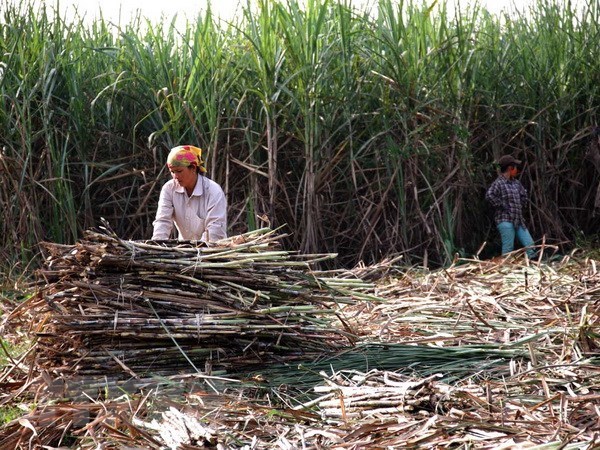
Farmers harvest sugarcane. The sugarcane sector is facing record-low prices despite an increase of 500,000 tonnes of output over last year (Photo: VNA)
Speaking at a conference held in Tay Ninh province on September 13, Pham Quoc Doanh, VSSA chairman, said the sugarcane sector faced a tough 2017 – 2018 crop as the volume of smuggled sugar remains high and inventories increase.
In addition to the large volume from the previous crop, the inventory for the new crop as of August 15 had reached more than 622,000 tonnes, about 67,584 tonnes higher than the same period last year, according to VSSA.
Sugar prices have also been falling in both domestic and world markets, with current prices at their lowest level in recent years.
Sugar mills are selling products at prices nearly equal to smuggled sugar, and some mills have sold sugar below production costs at 11,400-12,000 VND per kilo to reduce inventory.
Compared with previous crops, sugar prices fell by 3,000-5,000 VND per kilo on average, affecting many enterprises.
Pham Van Duy, deputy head of the Agro-Product Processing and Market Development under the Ministry of Agriculture and Rural Development (MARD), said falling sugar prices in the local market were due to a mismatch between supply and demand in the world market.
The price decrease is just one of the problems faced by the sugarcane industry.
For many years, manufacturers have struggled to maintain profits because mills are small and have low productivity and quality.
Sugar smuggling, mostly from Thailand, has also affected domestic manufacturers.
Thailand this year has produced 12 million tonnes of sugar, up by two million tonnes over the last crop.
Thai sugar is smuggled to neighbouring countries, including Vietnam, China, Cambodia, Laos and Myanmar.
“Management of smuggled sugarcane has not been effective. Cheap smuggled sugarcane imports are difficult to control, while sugar prices in the country are not competitive,” he noted.
In addition, the sugarcane cultivated area this year is likely to decrease because of falling prices, diseases and climate change.
In addition, farmers have converted sugarcane areas to other plants with higher economic value.
Tran Huu Tuan, a sugarcane farmer in Tay Ninh, said to overcome current challenges, the sugarcane industry needs support and direction from MARD.
“It is now necessary to remove difficulties for sugarcane mills to ensure benefits for sugarcane growers,” he said.
Restructuring
To compete with rivals, especially Thailand, experts recommend that the sugar industry undergo restructuring.
The sector needs to improve the sugar content in sugarcane, reduce production costs and eliminate intermediaries in the sugar distribution process.
In addition, sugar mills need to invest more in technologies to cut costs and improve quality, diversify their products, and produce organic products or sugar products that are good for health.
The association will continue to step up measures, including fighting against smuggling, establishing technical barriers, inspecting the quality of sugar in the market, and tightening checks of imports meant for re-export.
The country’s total sugarcane cultivated area reached 274,300ha last year, up 6,000ha compared to 2016, according to a report from MARD.
Last year’s total output reached 17.87 million tonnes, up 500,000 tonnes compared to 2016, according to the report.
Vietnam has more than 75 sugarcane varieties. However, over 90 per cent of sugarcane varieties cultivated in the country originated from overseas.
Thirty-seven out of 41 sugar mills operating across the country have total design capacity of 153,379 tonnes per day, but actual total capacity is only 136,000 tonnes, according to VSSA.
Four sugarcane mills have suspended operation, including Hiep Hoa, Kien Giang, Ca Mau and NIVL mills, due to great losses.
Co-organised by MARD and VSSA, the conference was held to identify new challenges and seek solutions, particularly in the context of Vietnam’s readiness to join the ASEAN Trade in Goods Agreement (ATIGA) in 2020./.
VNS/VNA
 Tay Ninh learns about Hydrogen production model in Japan
Tay Ninh learns about Hydrogen production model in Japan



